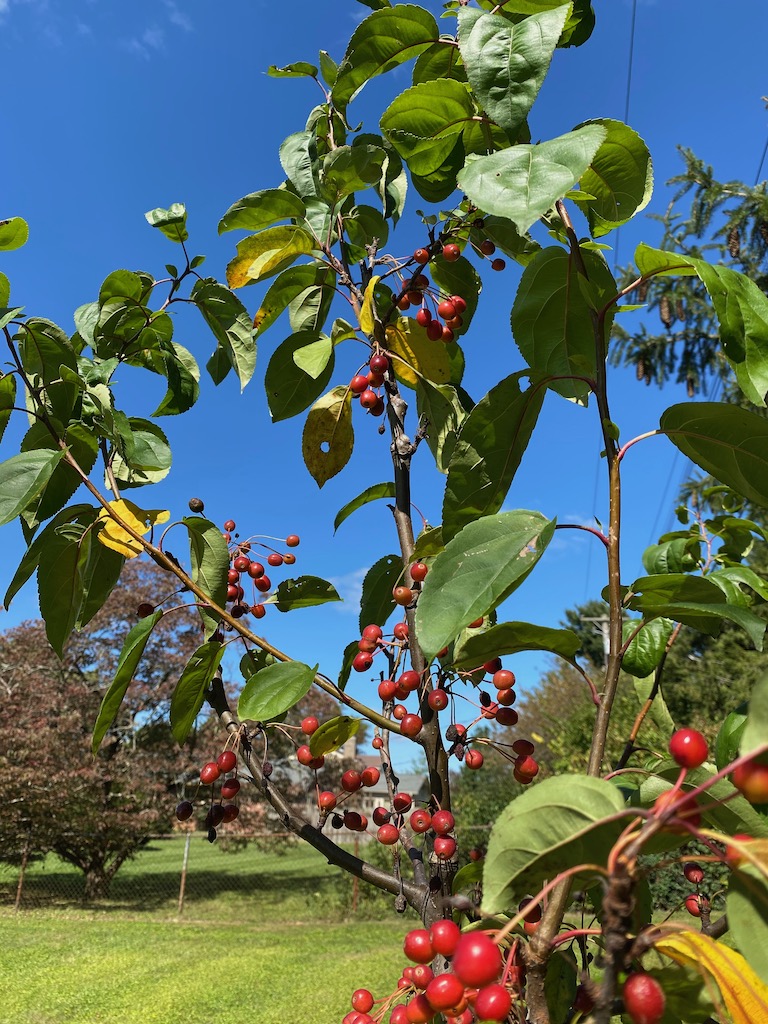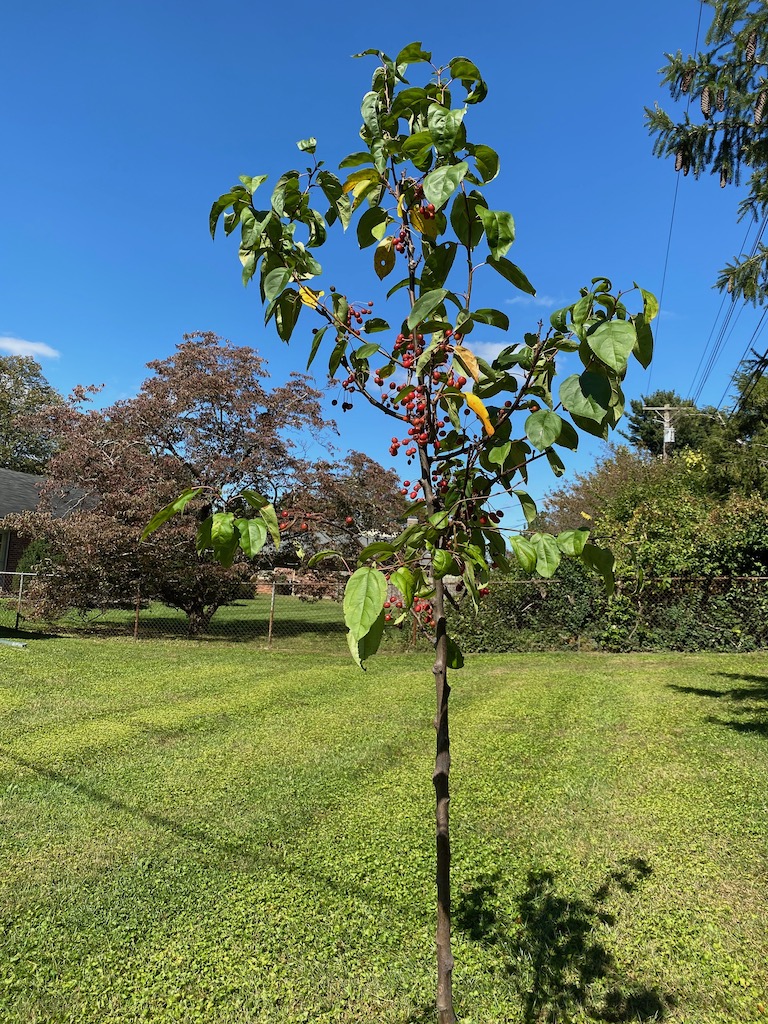As late summer shifted to fall this year, I decided to plant a tree. I’ve been adding shrubs and perennials where formerly only grass and violets grew, but planting a tree feels different. As a child, watching the growth of a sugar maple that I helped my grandfather plant taught me how a tree changes the landscape with its powerful presence. Planting a tree matters, and choosing well is a significant task.

I spent weeks mulling the options for a particular spot in my back yard. I wanted a tree that will flower in the spring, grow fruit I can share with the birds, and take on a pleasing rounded shape. It had to fit under the power lines. After much reading and google image searches, I finally narrowed the search to some variety of the crabapple.
Years ago, a spreading crabapple tree grew just outside the door to my children’s kindergarten. Perhaps memories from those days colored my choice. I can still see the tree full of children, as natural there as the fruit or the foliage. They clambered along its branches and tasted the sharp fruit, theirs for the taking, as their mothers or fathers lingered on the lawn at the end of the school day.
At local nurseries I encountered a plethora of dogwoods and redbuds and cherries—all lovely—but no specimens at all of the tree I was looking for. I was starting to question my choice until, at the third garden center I visited, I found not one but three varieties of crabapples. Jackpot! The nursery guy liked the Sugartyme, the only name I recognized from my research. It’s a good tree, but not quite the shape I hoped for. Snowdrift was another lovely specimen, with orange-red fruit and leaves turning gold in the October sun. The third variety was the Donald Wyman, bearing bright red fruit and glossy green foliage.
I pulled out my phone and compared pictures of the mature trees, read about their care, then walked for a while among the other trees and shrubs as I considered which to bring home. Returning to the crabapples banished any indecision. The colors of the Donald Wyman made me smile. Its shape already felt familiar, like the silhouette of a friend. I didn’t so much choose my tree as recognize it. This was the one I wanted to bring home.
The Donald Wyman is a species discovered at Harvard’s Arnold Arboretum in the 1950s. The tree is named for the head horticulturalist who found it. Nature made something new in that garden, and a naturalist with a trained eye and a continual presence in that place recognized the importance of the fresh arrival growing there. I’m glad he was paying attention.
With my back seat folded down, the tree man easily loaded it into my car through the hatchback. There was even room to bring home the Allegheny viburnum I had found on my tour of the garden center. When I got home and unloaded it, the tree brushed the top of the garage doorway—I had to set it out in the driveway to give it room to stand. I wheeled it around back and placed the container where I thought it should go. I studied the tree from different angles, including from inside the house, continually adjusting until it was perfectly placed.
Then there was the work of getting it into the ground. I gathered what I needed: shovel, pine mulch soil conditioner, Bio-tone fertilizer, and pine bark mulch, all carried or lugged or wheeled to the planting site. I dug a wide hole, not too deep, and made a nest of well-conditioned soil to welcome and protect the first year’s root growth. I made sure the slender trunk was straight and tall, and the prettiest branches facing where I’ll view my tree most often. I watered it in, and admired my work, and told the tree: I’m glad you’re here.
The next night we had some weather. The sky darkened toward evening and the wind blew hard. The leaves and branches and entire upper half of the tree bent under its force, whipping back and forth. The young tree seemed so vulnerable out there, and some deep and non-rational protective instinct cringed at having left it to the elements all on its own. As if I should have kept it inside? Of course that didn’t make sense. And another part of me, seeing things more objectively, recognized that this is what the tree is made for. By some miracle, it is created to live in the elements, to weather the seasons, to grow and thrive in a full range of experience. I will water it and give it every support I can. But like the children all those years ago, now grown, this tree is meant to have its own life.
In the hour after I planted the tree, a robin swooped toward a slight branch, then seemed to change his mind about its ability to hold him. A smaller mockingbird lit briefly, then flew away. A couple days later I watched a blue jay pluck one of the bright red crabapples. When the fruit dropped to the ground he followed, pecking away at the skin until the round morsel in his beak glowed creamy yellow in the afternoon sun.
I’m invested in this tree, its place in the landscape, its relationship with the birds in its branches and the chipmunks at its base. I look forward to witnessing the amber color of its leaves in the coming weeks, and its fragrant white blossoms in the spring. Its growth in any moment is imperceptible, yet if all goes well it will achieve a height and breadth that changes the landscape. Life flows through the tree, and the jay, and me. For this glorious time we’re given, we are here.

